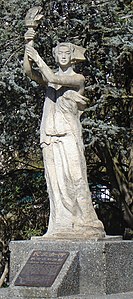
Goddess of Democracy
The Goddess of Democracy, also known as the Goddess of Democracy and Freedom, the Spirit of Democracy,[1] and the Goddess of Liberty (自由女神; zìyóu nǚshén[1]), was a 10-metre-tall (33 ft) statue created during the 1989 Tiananmen Square protests. The statue was constructed over four days out of foam and papier-mâché over a metal armature and was unveiled and erected on Tiananmen Square on May 30, 1989. The constructors decided to make the statue as large as possible to try to dissuade the government from dismantling it: the government would either have to destroy the statue—an action which would potentially fuel further criticism of its policies—or leave it standing. Nevertheless, the statue was destroyed on June 4, 1989, by soldiers clearing the protesters from Tiananmen square. Since its destruction, numerous replicas and memorials have been erected around the world, including in Hong Kong, San Francisco, Washington, D.C., and Vancouver.[2]
For Hong Kong replicas of the same name, see Goddess of Democracy (Hong Kong).Goddess of Democracy
民主女神
mínzhǔ nǚshén
mínzhǔ nǚshén
Minchu Nüshen
民主精神
mínzhǔ jīngshén
mínzhǔ jīngshén
Minchu Chingshen
Fall of the Goddess[edit]
The soldiers were able to fulfill their timeline of reaching the Square on June 4, 1989, by 1 a.m. through the use of tanks and armored personnel carriers. The Goddess of Democracy had stood for only five days before being destroyed by soldiers of the People's Liberation Army in the assault on Tiananmen that would end the Democracy Movement.[4] The toppling of the Goddess of Democracy was seen by millions across the world on television: "pushed by a tank, it fell forward and to the right, so that its hands and the torch struck the ground first, breaking off."[4] As the statue fell, protestors shouted "Down with Fascism!" and "Bandits! Bandits!"[6] It was "quickly and easily reduced to rubble, mixing with all the other rubble in the Square. To be cleared away by the Army".[4] By 5:40 a.m. a negotiated settlement allowed the remaining students to leave by the south-eastern corner of the square. The army had fulfilled its order to clear the Square by 6:00 am. Clashes continued throughout the city and in other towns across China.[6]
The original statue has become an icon of liberty and a symbol of free speech and democracy movements.[7] The Chinese government has tried to distance itself from any discussions about the original statue or about the Tiananmen Square protests, and in the case of the Victims of Communism Memorial it called the building of a replica an "attempt to defame China".[7]
Several replicas of the statue have been erected worldwide to commemorate the events of 1989:
Tsao Tsing-yuan, an advisor to the students who built the original, writes "I myself envision a day when another replica, as large as the original and more permanent, stands in Tiananmen Square, with the names of those who died there written in gold on its base. It may well stand there after the Chairman Mao's Mausoleum has, in its turn, been pulled down."[4]





